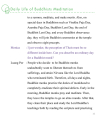Buddhist Canon : ค้นหาหนังสือธรรมะ
หน้าหนังสือทั้งหมด

34
Understanding Dhammakāya in Early Buddhist Thought
II. The Different Approach
A fairly established academic understanding has settled regarding the term dhammakāya in the Pali canon, that it was used merely in the sense of the ‘Buddha’s teachings.’ In
The term 'dhammakāya' in the Pali canon is understood as representing the Buddha's teachings. It is established through several canonical passages that equate the Buddha with dhamma. Notable reference

90
Buddhist Manuscripts from Sipsong Panna Region
Buddhist manuscripts from the Sipsong Panna region can be divided into four categories. The first category consists of the Dai Pāli Tripiṭaka and Tripiṭaka commentary (三藏琢) which is represented by fiv
Buddhist manuscripts from the Sipsong Panna region are categorized into four main groups: the Dai Pāli Tripiṭaka and Tripiṭaka commentary, frequently used Pāli Canon texts, Theravāda Buddhist literatu

63
Understanding Paccekabuddhas in Buddhist Philosophy
… Jainism. Gombrich proposes also that the assimilation of the concept regarding Paccekabuddhas into Buddhist canon could have resulted from an actualisation of ‘an interstitial category’ inferred logically. Norman,…
This text discusses the concept of Paccekabuddhas, individuals of high wisdom who achieve self-enlightenment but lack the ability to teach. It explores scholarly arguments about the pre-Buddhist origi

50
Computerization of the Buddhist Pali Canon
The text in the image reads:
"The Computerization of the Buddhist Pali Canon
With the recognition that many world scholars have been impeded from fully studying the Buddhist scriptures by inconvenie
The Computerization of the Buddhist Pali Canon began in 1984 by the Dhammakaya Foundation to improve access for scholars worldwide. Utilizing the Romanized Pali Canon Text, the project produced a data

2
World Buddhist Sangha Youth Organization
WORLD BUDDHIST SANGHA YOUTH
OBJECTIVE
* To develop Buddhist youth organization and exchanges of Buddhist Sangha youth worldwide.
* To assist Buddhist Sangha youth activities throughout the world.
* T
The World Buddhist Sangha Youth (WBSY), founded by Venerable Mugunuwela Anuruddha Thera in 2004, aims to develop Buddhist youth organizations and facilitate international exchanges among young Buddhis

32
Dhamma-kāya in the Pali Canon
Dhamma-kāya in the Pali Canon¹
Chanida Jantrasrisalai
I. Why ‘Dhamma-kāya’ in the ‘Pali Canon’?
The term dhamma-kāya/dharmakāya appears in Buddhist literature of different schools. Previous scholars
The study investigates the term dhamma-kāya as presented in the Pali Canon, aiming to provide a comprehensive analysis that has been overlooked in previous studies. While many references have been mad

84
Bibliography of Buddhist Studies
Bibliography
Dutt, Nalinaksha. Mahayana Buddhism. Delhi: Motilal Banarsidass, 1978.
Geiger, Wilhelm. “Dhamma and Brahman.” Zeitschrift flour buddhismus (1921): 73-83.
Gombrich, Richard. “The Buddha’s
This bibliography encompasses significant scholarly works in Buddhist studies, offering insights into various aspects such as the early Buddhist philosophy, the concept of Dharmakāya, and teachings of

87
Buddhist Manuscripts in China: Theravāda Buddhism in Sipsong Panna
Buddhist Manuscripts in China: A Case Study of Theravāda Buddhist Manuscripts in Sipsong Panna (Xishuangbanna, Yunnan Province, PRC)
Joe Zhou Ya
China, like many other countries in the world, is a c
This article delves into the rich tapestry of Buddhist culture in China, specifically focusing on the Theravāda Buddhism of the Dai people in Sipsong Panna, Yunnan Province. Buddhism's introduction to

95
Dai Buddhist Manuscripts in Yunnan's Dehong Prefecture
It is noteworthy that there is a community of Dai people in the Dehong Autonomous Prefecture in the west of Yunnan, and a wide range of Buddhist manuscripts are stored there. Palm-leaf manuscripts are
This text discusses the unique tradition of Buddhist manuscripts among the Dai people in Dehong Autonomous Prefecture of Yunnan, where various types of manuscripts are produced. Most texts utilize sa-

131
Eastern Han Buddhist Meditation and Daoism
Eastern Han Buddhist meditation and Daoism
By the middle of the first century CE, a Buddhist community was already in existence in China, and growing. The arrival of translators from Central Asia and
By the first century CE, Buddhism had begun to take root in China, with translators arriving from Central Asia and India to convert texts into Chinese. They initially faced challenges in accurately co

3
The Relationship between Jātaka Stories in Buddhist Scriptures and Bharhut Stupa Sculptures
The Relationship between Jātaka stories in Buddhist Scriptures and Those in Sculptures of Bharhut Stupa
Pramaha Pongsak THANIO
Abstract
This paper presents a study on the relationship between Jātaka
This study delves into the intricate relationship between the Jātaka stories found in Buddhist scriptures and the sculptures at Bharhut stupa. It identifies that many of these sculptures are rooted in

36
References to 'Dhammakāya' in the Pāli Canon
III. References to 'Dhammakāya' in the Pāli Canon
In the Pali canon, the term dhammakāya appears four times: once in the Aggiāṇā-sutta of the Dīgha-nikāya and three more times in Apadāna literature.
In the Pāli Canon, the term 'dhammakāya' is found four times, significantly in the Aggiāṇā-sutta and Apadāna literature. It serves various roles including a designation for the Tathāgata and associati

3
Garudhamma 8: Exploring Gender Issues in Buddhism
Garudhamma 8
What did the Lord Buddha Establish?
Wilaiporn SUCHARITTHAMMAKUL
Abstract
This paper deals with the Buddhist outlook on gender issues. Contemporary feminists have extrapolated moder
This paper examines the Buddhist perspective on gender issues, particularly the eight garudhamma, which have been contested in modern debates around gender equality. It investigates whether these teac

10
Congratulatory Letter for Dhammachai International Research Institute
**Congratulatory letter**
The 60th Dhammachai Education Foundation of Australia and New Zealand has developed an increasing commitment in recent years to the academic study of the Buddhist tradition,
The 60th Dhammachai Education Foundation of Australia and New Zealand has strengthened its commitment to studying the Buddhist tradition. The foundation established the Dhammachai International Resear

252
Exploratory Insights into Early Buddhist Texts and Practices
Jantrasrisalai, Chanida. 2011. “Criteria for Identification of Elements of Dhammikāya Meditacionds., Early Buddhist Traces of Dhammikāya Meditation : Project Overview.
Keenam P. John. 1982. Original p
This text presents an overview of significant scholarly works on early Buddhist practices and literature, focusing on the criteria for identifying elements of Dhammikāya meditation and examining the p

72
Understanding Vinaya: The Code of Conduct in Buddhism
…ations'on the behaviour of individuals. As a collection, it is the name of the first portion of the Buddhist Canon [Vinaya-piṭaka] which deals with the proper behaviour of the members of the Buddhist community, suc…
… community, particularly monks and nuns. It encompasses the Vinaya-piṭaka, the first portion of the Buddhist Canon, detailing appropriate behavior and the Five Precepts for laypeople. Monks adhere to 227 precepts, …

3
Analyzing the Dhammacakkappavattana Sutta: A Text-Critical Approach
The Document Research Methods
Case Study: The Dhammakakkappavattana Sutta
Pramaha Pongsak THANIO
Abstract
Dhammacakkappavattana Sutta (Sanskrit: Dharmacakaravartana
Sutra) is regarded as one of the
The Dhammacakkappavattana Sutta, a key Buddhist text, shows multiple versions arising after the Buddha’s death, raising authenticity questions. This research employs text-critical methods to establish

16
Launch of the Journal of the Dhammachai International Research Institute
Introduction
This collection of articles marks the launch of the Journal of the Dhammachai International Research Institute (JDIRI). The articles presented here indicate some of the perspectives on B
This collection of articles marks the launch of the JDIRI, showcasing perspectives on Early Buddhism and meditation studies. The journal aims to publish research on ancient manuscripts and esoteric pr

59
The Importance of Chanting in Buddhism
your mind will clear and be open to receive merit. Your thoughts, speech, and action will not be led astray by temptation.
Performing Vatta serves constantly to remind us of the virtues of the Triple
Chanting in Buddhism plays a crucial role in enhancing faith and preserving teachings of the Buddha. It reminds practitioners of the virtues of the Triple Gem and helps them avoid temptation. Historic

45
Daily Life of Buddhist Monks
Daily Life of Buddhists Meditation
Monica
to a sermon, meditate, and make merits. Also, on
special days in Buddhism such as Visakha Puja Day,
Asarnha Puja Day, Buddhist Lent Day, the end of
Buddhist L
This text delves into the daily routines of Buddhist monks, highlighting their commitment to spiritual growth through meditation, alms rounds, and adherence to the teachings of the Lord Buddha. Monks
